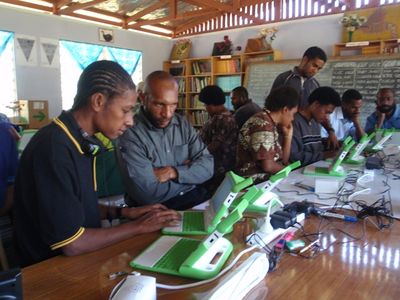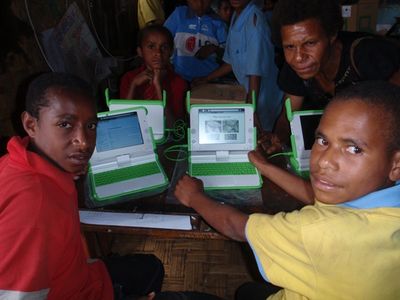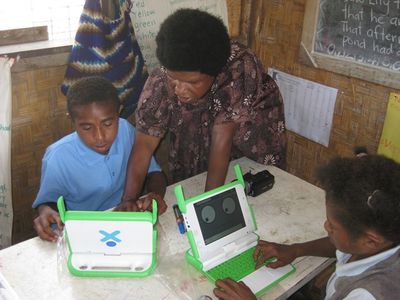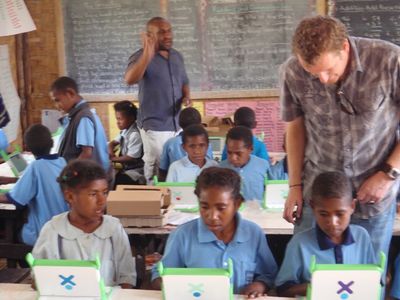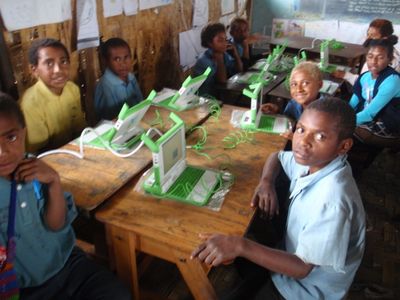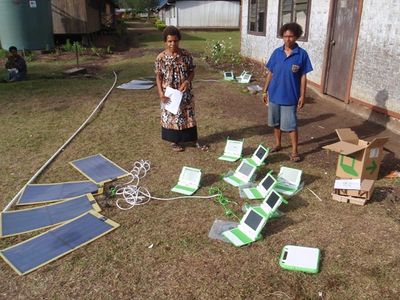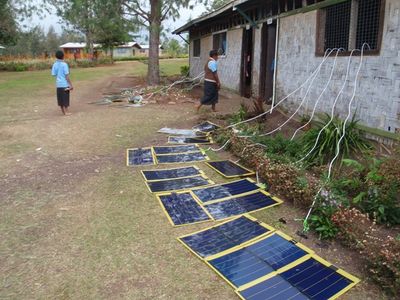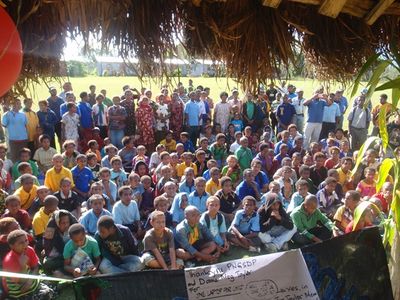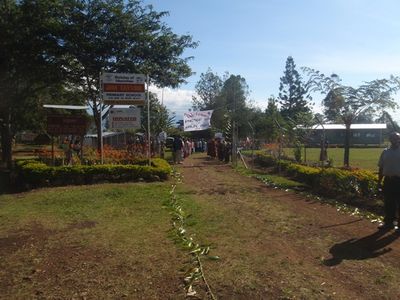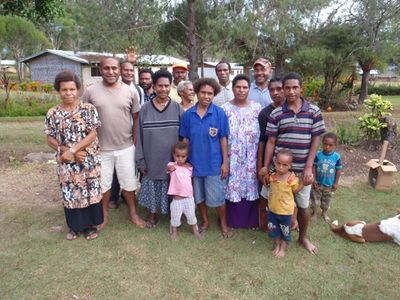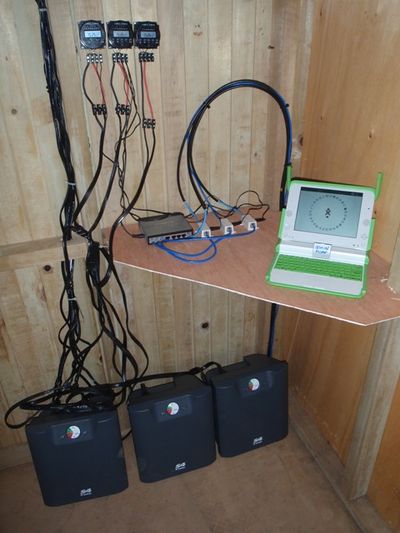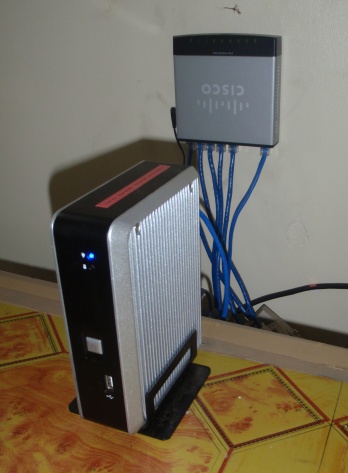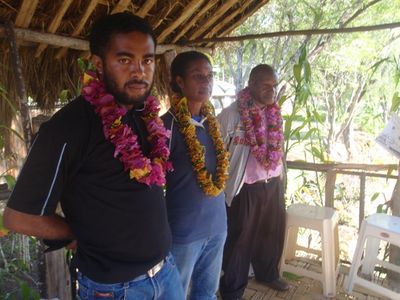OLPC PNGSDP/Kisap
Rumginae Primary School -
Jim Taylor Memorial Primary School, Kisap -
Matkomai Primary School -
Finalbin Primary School -
The 3 Telefomin Primary Schools
Related Links: OLPC PNG Blog Site (DWU) -
OLPC wiki pages for PNG (2008)
Tools: Lesson Plan Template - Draft lesson plans - Webquest template - Draft webquests
Contents
Jim Taylor Memorial Primary School OLPC Project
Latest news and feedback from the school
We hope that a regular flow of feedback (and eventually data from an M&E programme) will be posted here.
Feedback from Laura Hosman
Laura is Assistant Professor of Political Science at Illinois Institute of Technology. She visited Kisap one week after the deployment (Aug 2010). From her web log ICT4D Views from the Field:
- Visit to Jim Taylor Primary School Kisap PNG part 3 OLPCs in the classroom
- Visit to Jim Taylor Primary School Kisap PNG part 2 Background and Politics
Networking and solar seem to be working well, and everyone was extremely enthusiastic! Brief summary is below. I hope to update the following page with more information, photos, etc., (on her web log). All the best, Laura
- 3rd through 5th grade classes were able to use the laptops with the solar and the share cables. Teachers from all grades were able to use the laptops for lesson planning.
- All (students and teachers) were extremely enthusiastic about the XOs, and the equipment all seemed to be functional.
- In the 5th grade class, I watched the students use the Paint program, to draw people in (traditional PNG) costume. It was very exciting to see them use their creativity! This assignment was a continuation of what they had been doing in the classroom before using the XOs. The students were enjoying themselves, they didn’t want to go to lunch, and ended up staying a half-hour into their lunch hour!
- The 3rd grade (combined) classes and used the Speak program to work on English pronunciation. The students were extremely excited and enthusiastic!
- The 4th grade students demonstrated that the mesh networking was working among themselves, then used two laptops to venture outside and measure the distance between, or length, of a number of places/locations/objects
Feedback from Mathew Umbe, Head Teacher
Message 1 from Jim Taylor Primary School. via James Suki, Welfare Officer, Baptist Education Authority, Mt Hagen (Aug 20 2010)
It’s about 3 weeks now after our training and installation of the OLPC at our school. The teachers and students are using the laptops daily. Teachers have a diary for each class. We also have a school diary. Students are catching up very well on using the laptops. All equipments are working very well. Server turns off and on automatically as set. Server is not accessible at all teachers’ residences. We’ve also created an OLPC inventory for the school during the School Based In-services. Two teachers have been tasked to be responsible for the OLPC project at the school. All progressing well, keep in touch. Mathew Umbe
Note: The wireless network has a minor component left to complete, hence the patchy coverage in staff houses. This will be fixed soon.
Message 2 from Jim Taylor Primary School (Sept 1st 2010)
Hello, we have opened our own Email address. It's as follows; jtmpskisap AT gmail.com. All laptops are working. Our students and teachers are using them. Several parents have been allowed to observe the students using the xo and are very thankful of the initiative taken by PNGSDP. The whole community here is looking forward for a colourful launching of the project. We are also very thankful for the team of technicians who trained us and did the installation. So much for now. Thank you Mathew Umbe, Headteacher
Note: the launching is set for October 2010.
Details in pictures
The teacher and student training and installation of the server, solar and wireless infrastructure took place during the two weeks at the end of July, 2010. Jim Taylor School is a church school run by the Baptist Education Authority, whose Welfare Officer, James Suki, attended the entire training and is coordinating communications and support (contact welfareofficer@ At global.net.pg).
Activities completed in July 2010
- 219 Laptops and chargers delivered
- 100 GP solar panels delivered (about half what are needed), sufficient to allow the launching to proceed, with about 20 power boards for interim charging
- Server, wireless and solar power installation completed
- Teachers trained in
- basic operation of XOs and Activities
- server use
- basic classroom planning
- use of DC Share cables and GP solar panels
- Laptops allocated to students and server fully set up with class groups. Laptops held by school until launching.
- Action plan developed for the school in the short term (see below)
- Agreement on support system via Baptist Education agreed
- Visits by provincial/district inspector and education officials, and the DoE
Launching can proceed at agreed time. The partners (Baptist Education, Provincial Education, Dame Meg Taylor, SDP, DWU) will discuss ways of completing the school, and then sustaining it each year.
Names of teachers trained
| |
|
TITLE | OFFICER | SEX | |
POSITION NO | GRADE
TEACHING |
| |
|
H / T | MR. MATHEW UMBE | M | 0032896A | 1090149815 | 7&8 |
| |
|
DHT | MRS. ELIZABETH KULNO | F | 00040673 | 1090098228 | 5A |
| |
|
S / T | MR. GELE KUPO | M | 004587767 | 1090101433 | 6A |
| |
|
S / T | MR. STEVEN TELA | M | 00575909 | 1090123256 | 7 & 8 |
| |
|
S / T | MRS. MARIA AIPE | F | 0007870A | 1090144870 | 4B |
| |
|
A / T | MR.PETER STEVEN | M | 10321181 | 1090098218 | 5B |
| |
|
A / T | MR. GORDON DIMA | M | 10190808 | 109098219 | 7 & 8 |
| |
|
A / T | MRS. ALICE KOKELE | F | 00411108 | 1090098220 | 3A |
| |
|
A / T | MR. WENA IMBAL | M | 10322277 | 1090108589 | 7 & 8 |
| |
|
A / T | MRS. EVELYN ATA | F | 00588849 | 1090123255 | 7 & 8 |
| |
|
A / T | MR. MICHAEL KUPUL | M | 10195962 | 1090128609 | 7 & 8 |
| |
|
A / T | MISS. ESTHER MUSIVE | F | 10196806 | 1090144869 | 7 & 8 |
| |
|
A / T | MRS. LENA OMGARYE | F | 01413224 | 1090149814 | 4A |
| |
|
A / T | MISS. JANET JAMES | F | 10073190 | 1090356240 | 3B |
| |
|
A / T | MR. CASPAR WILFRED | M | 10195962 | 1090356241 | 6B |
Summary of remaining actions
- Add omni-directional antenna and 2 additional access points
- The remaining 119 GP solar panels to be delivered
- Official launching
Action Plan for teachers (short term)
BEFORE LAUNCHING
- Each teacher should start an OLPC dairy in an exercise book. Each time you use the laptop in a lesson, record how it was used and how you used it, for example (a) for lesson preparation, (b) research (subject knowledge), (c) to create educational materials or (d) administrative purposes. You can also indicate when it was useful for any private purposes (community events, etc). Also record any problems encountered (important so that they can be addressed and solved). Note: this should be an easy task to do. Only half a page or even just a couple of sentences if the usage is a simple one. It could be done at the end of the day. But also, you are welcome to add as much detail as possible! Later on, we can agree on a template for a standard form to complete. This will be linked to the monitoring and evaluation. Please continue with this task and when dairies are full, archive them with their sequence number or dates and teacher name, etc. For more of a challenge, do the diary using your XO and upload to the server (create a folder for it).
- On a minimum of 2 days per week (does not have to be same time as other teachers – in fact it will work better with reduced numbers on the server). Take out the DC Share cables (the white cables) and the flexible solar panels for your entire class. Have the laptops all connected to the cables all day long (important). You can have them stacked up at the side of the room when you don’t need the students to have them on. Make sure they are turned off when not being used. When you want to use the laptops, the students arrange themselves in groups of 4. AT the end of the day, replace the panels and cables. NOTE: This will be MUCH easier when secure boxes are made in each classroom and students learn to quickly set it all up.
- Hold a weekly Teachers OLPC Club meeting. Compare dairy notes and discuss ideas for classroom use, and write them down for reference. Write down any problems that you have encountered. One teacher can then write a short report (1 page is OK) which can be printed and given to James Suki (or otherwise) to email to the OLPC-PNGSDP email support group. This will keep the partners informed of what is happening and any problems so that we can email back advice. In the report, just write how often each class has used the laptops, for what purposes, (you can list the “highlights” from each teacher’s diary – or each teacher can supply a short report of their “highlights” and “problems”). The IMPORTANT thing is to keep communicating on a regular basis!!
- Integrate the technology into your weekly SCHOOL BASED IN SERVICE TRAINING. This means that you give a few minutes at least, to discuss how the laptops and server could assist in regard to the training topic (for instance if you are dealing with assessment, consider how the laptops can be used to record or measure what you are assessing). If you come up with good ideas, document them and share with us so we can help you develop them and mainstream them (align with the Department’s programmes).
- Hold one or more short occasions when the parents can come in and see the children using the laptops. Explain the 5 core principles (see your training notes) and show them the parents agreement. Maybe a half day “open day” at the weekend
- The school can either use Jame Suki to keep in touch via email, or create a free webmail account and use that. It is important that the email address to be used is added to the “OLPC-PNGSDP” email support group. You will then send one email, and everyone will receive it (all the schools in the project, DWU, support people, etc).
- In your own time (such as evenings when connected to the server, read the important documents on the server (or the printed copies), especially the Solomon Islands Evaluation report. That will give you feedback from your counterpart teachers there, and also parents, students and officers . This will assist with expectations.
THE LAUNCHING
- Prepare for the launching. Sign all the Parents agreements and write the students names in advance. Make an OLPC asset register and list the names of the students with the laptop serial number (from the plastic bag or behind the battery).
- You will be calling up each student with their parent or guardian, give the child the laptop and the parent signs the agreement and takes it as a record. At the same time, the asset book can be ticked to indicate the handover completed.
- Set up the classrooms with the full system (including the flexible panels) and check it is all working. Select a few students in each class to be able to demonstrate some features (it is OK that they are not very used to the laptop yet, after they keep them they will quickly become experts). When the ceremony is over, arrange for the students to go to their classrooms and get ready. Then, the VIPs can tour the classrooms to see the students using the laptops, ask questions of the teachers etc. The media will enjoy that.
- When the launching is over, the laptops should now be brought in to class each day by the students. You should now have the secure box for the solar panels, and these should be set up at the beginning of each day with the laptops connected to them all day so that they charge, and so that they can be used as you start to design lesson plans using the laptops.
GOOD LUCK AND BEST WISHES FOR YOUR OLPC PRGRAMME!

